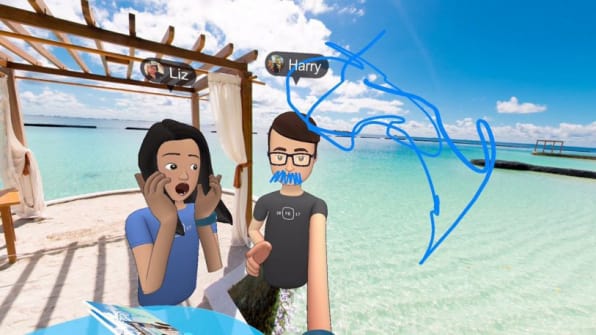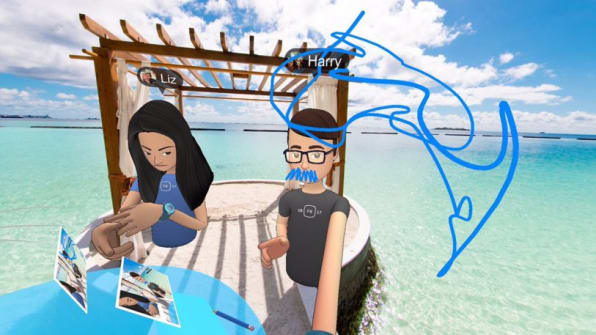If you ask people at Facebook about why the company created Facebook Spaces VR, its new virtual-reality chat environment for Oculus, they will likely wax eloquent about the company’s mission of promoting social connections between friends, and why VR might be an increasingly important part of fulfilling that goal.
Here at Facebook’s F8 developer conference, however, the demo I got of Spaces involved a lengthy wait in a line that turned out to be even longer than I thought it was when I got in it. And then five minutes of giddy fun with strangers. And after that, a little pang of regret that it was over.
In short, it felt more like a theme-part attraction than an advance in human interaction. Perhaps that’s why I came away favorably impressed, or at least entertained.
I’m certainly not the only person who’s had a good time in Spaces, which–once you’ve strapped on an Oculus Rift headset and grabbed two Oculus Touch controllers–turns you into a legless floating cartoon avatar of yourself and then lets you interact with other people’s avatars in VR, doodle in 3D space, take virtual selfies, and perform a few other feats. Engadget‘s Nicole Lee, who also demoed the service here at F8, seemed to like it. So did the F8 attendee who I shared my few minutes of VR with.

Much of the initial reaction to Spaces, however, both from folks who have given the service a go and those who have merely followed coverage of it, is not, um, kind:
“This is a horror show. Disembodied torsos? Virtual selfie sticks? This looks like the way people would socialize in a post-apocalyptic scenario where everyone is quarantined in a bunker to shelter themselves from the zombie virus.”–John Gruber, Daring Fireball
“As with Oculus itself, I can’t help but feel Facebook has its priorities backward. Both companies are acting like VR is already mainstream, and they’re building VR experiences for a mainstream audience—one that absolutely does not exist, in the current landscape.”–Hayden Dingman, PCWorld
“What’s so depressing is that the deep interaction Facebook wants its users to have requires strapping on a large virtual-reality helmet and sitting somewhere quietly at the same time your friends do the same thing. If you really wanted to interact with your friends, why not just do a Google Hangout or a Skype call?”–Mike Murphy, Quartz
I’m not here to argue that these takes are invalid. Actually, I agree with aspects of them. Spaces isn’t intriguing as a substitute for something simple, accessible, and pervasive like Skype. Or a reason to spend $ 600 for a Rift and the Touch controllers. Or something so compelling that strapping on a VR headset suddenly stops feeling odd.
I’m not even ready to hazard a guess about how appealing a way it is to engage with friends, since I mostly goofed off and amused myself. My human interactions consisted largely of paying attention to Liz, the Facebook employee who was helping us through the experience; for what it’s worth, the technology worked, her animated avatar was surprisingly expressive, and it quickly felt natural, or at least not overly unnatural.
My instinctive reaction to a few minutes in Spaces VR was pretty simple: Hey, this is the closest I’ve ever come to feeling like I was a cartoon character. Maybe there’s something about that idea that appeals to me–a couple of decades ago, I was fascinated by a piece of software from Microsoft called Comic Chat, which turned instant messaging into a comic strip.

Facebook Spaces VR, or something like it, won’t become mainstream until Oculus Rift-level VR is far cheaper and less cumbersome. That’s going to take years, a fact we knew before Spaces’ debut. Facebook, if it so chooses, can continue to invest in the concept and weather skepticism until the technology catches up with the company’s visions for VR-based social networking. For now, Spaces feels like a toy, and I mean that as a compliment.
And hey, it just dawned on me–I never actually met Liz in person. In fact, I’m not even sure where she was in real life, though I imagine it was elsewhere in the Spaces VR pavilion at the San Jose Convention Center. And yet I do feel like I spent a little bit of time in her company.
Maybe that’s a sign that Spaces, even in its current form, has achieved something worthwhile, albeit quirky and experimental, in terms of human communication after all.
(77)
